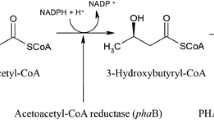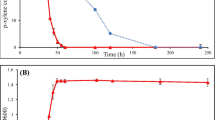Abstract
Pseudomonas putida NCIMB 9866 utilizes p-cresol or 2,4-xylenol as a sole carbon and energy source. Enzymes catalyzing the oxidation of the para-methyl group of p-cresol have been studied in detail. However, those responsible for the oxidation of the para-methyl group in 2,4-xylenol catabolism are still not reported. In this study, real-time quantitative PCR analysis indicated pchC- and pchF-encoded p-cresol methylhydroxylase (PCMH) and pchA-encoded p-hydroxybenzaldehyde dehydrogenase (PHBDD) in p-cresol catabolism were also likely involved in the catabolism of 2,4-xylenol. Enzyme activity assays and intermediate identification indicated that the PCMH and PHBDD catalyzed the oxidations of 2,4-xylenol to 4-hydroxy-3-methylbenzaldehyde and 4-hydroxy-3-methylbenzaldehyde to 4-hydroxy-3-methylbenzoic acid, respectively. Furthermore, the PCMH-encoding gene pchF was found to be necessary for the catabolism of 2,4-xylenol, whereas the PHBDD-encoding gene pchA was not essential for the catabolism by gene knockout and complementation. Analyses of the maximum specific growth rate (μ m) and specific activity of the gene-knockout strain to different intermediates revealed the presence of other enzyme(s) with PHBDD activity in strain 9866. However, PHBDD played a major role in the catabolism of 2,4-xylenol in contrast to the other enzyme(s).



Similar content being viewed by others
References
Bradford MM (1976) A rapid and sensitive method for the quantitation of microgram quantities of protein utilizing the principle of protein-dye binding. Anal Biochem 72:248–254. doi:10.1016/0003-2697(76)90527-3
Chapman PJ, Hopper DJ (1968) The bacterial metabolism of 2,4-xylenol. Biochem J 110:491–498
Cronin CN, McIntire WS (1999) pUCP-Nco and pUCP-Nde: Escherichia-Pseudomonas shuttle vectors for recombinant protein expression in Pseudomonas. Anal Biochem 272:112–115. doi:10.1006/abio.1999.4160
Cronin CN, Kim J, Fuller JH, Zhang XP, McIntire WS (1999) Organization and sequences of p-hydroxybenzaldehyde dehydrogenase and other plasmid-encoded genes for early enzymes of the p-cresol degradative pathway in Pseudomonas putida NCIMB 9866 and 9869. DNA Seq 10:7–17
Dean HF, Cheevadhanarak S, Skurray RA, Bayly RC (1989) Characterisation of a degradative plasmid in Pseudomonas putida that controls the expression of 2,4-xylenol degradative genes. FEMS Microbiol Lett 61:153–157
Dehio C, Meyer M (1997) Maintenance of broad-host-range incompatibility group P and group Q plasmids and transposition of Tn5 in Bartonella henselae following conjugal plasmid transfer from Escherichia coli. J Bacteriol 179:538–540
Dennis JJ, Zylstra GJ (1998) Plasposons: modular self-cloning minitransposon derivatives for rapid genetic analysis of gram-negative bacterial genomes. Appl Environ Microbiol 64:2710–2715
El-Mansi EMT, Hopper DJ (1990) Resolution of the 4-hydroxy-3-methylbenzoate hydroxylase of Pseudomonas putida into two protein components. FEMS Microbiol Lett 66:147–152. doi:10.1111/j.1574-6968.1990.tb03987.x
Elmorsi EA, Hopper DJ (1977) The purification and properties of 4-hydroxyisophthalate hydroxylase from Pseudomonas putida NCIB 9866. Eur J Biochem 76:197–208. doi:10.1111/j.1432-1033.1977.tb11585.x
Hoang TT, Karkhoff-Schweizer RR, Kutchma AJ, Schweizer HP (1998) A broad-host-range Flp-FRT recombination system for site-specific excision of chromosomally-located DNA sequences: application for isolation of unmarked Pseudomonas aeruginosa mutants. Gene 212:77–86. doi:10.1016/S0378-1119(98)00130-9
Hopper DJ (1978) Incorporation of [18O]water in formation of para-hydroxybenzyl alcohol by para-cresol methylhydroxylase from Pseudomonas putida. Biochem J 175:345–347
Hopper DJ, Taylor DG (1977) The purification and properties of para-cresol-(acceptor) oxidoreductase (hydroxylating), a flavocytochrome from Pseudomonas putida. Biochem J 167:155–162
Inoue J, Shaw JP, Rekik M, Harayama S (1995) Overlapping substrate specificities of benzaldehyde dehydrogenase (the xylC gene product) and 2-hydroxymuconic semialdehyde dehydrogenase (the xylG gene product) encoded by TOL plasmid pWW0 of Pseudomonas putida. J Bacteriol 177:1196–1201
Jones RM, Collier LS, Neidle EL, Williams PA (1999) areABC genes determine the catabolism of aryl esters in Acinetobacter sp. Strain ADP1. J Bacteriol 181:4568–4575
Keen NT, Tamaki S, Kobayashi D, Trollinger D (1988) Improved broad-host-range plasmids for DNA cloning in Gram-negative bacteria. Gene 70:191–197. doi:10.1016/0378-1119(88)90117-5
Kim JH, Fuller JH, Cecchini G, McIntire WS (1994) Cloning, sequencing, and expression of the structural genes for the cytochrome and flavoprotein subunits of p-cresol methylhydroxylase from two strains of Pseudomonas putida. J Bacteriol 176:6349–6361
Livak KJ, Schmittgen TD (2001) Analysis of relative gene expression data using real-time quantitative PCR and the \( {2}^{-\mathit{\Delta \Delta }{C}_T} \) method. Methods 25:402–408. doi:10.1006/meth.2001.1262
Mackintosh RW, Fewson CA (1988) Benzyl alcohol-dehydrogenase and benzaldehyde dehydrogenase-II from Acinetobacter calcoaceticus—substrate specificities and inhibition studies. Biochem J 255:653–661
Mcintire W, Singer TP (1982) Resolution of p-cresol methylhydroxylase into catalytically active subunits and reconstitution of the flavocytochrome. FEBS Lett 143:316–318. doi:10.1016/0014-5793(82)80124-5
Rudolphi A, Tschech A, Fuchs G (1991) Anaerobic degradation of cresols by denitrifying bacteria. Arch Microbiol 155:238–248. doi:10.1007/BF00252207
Saltikov CW, Newman DK (2003) Genetic identification of a respiratory arsenate reductase. P Natl Acad Sci USA 100:10983–10988. doi:10.1073/pnas.1834303100
Zhang JJ, Liu H, Xiao Y, Zhang XE, Zhou NY (2009) Identification and characterization of catabolic para-nitrophenol 4-monooxygenase and para-benzoquinone reductase from Pseudomonas sp. strain WBC-3. J Bacteriol 191:2703–2710. doi:10.1128/Jb.01566-08
Zwietering MH, Jongenburger I, Rombouts FM, Vantriet K (1990) Modeling of the bacterial growth curve. Appl Environ Microbiol 56:1875–1881
Acknowledgments
We thank Professor David Hopper of Aberystwyth University for the helpful discussion. This study was supported by the National Key Basic Research Program of China (973 Program, grants 2012CB725202 and 2012CB721003).
Author information
Authors and Affiliations
Corresponding author
Electronic supplementary material
Below is the link to the electronic supplementary material.
ESM 1
(PDF 102 kb)
Rights and permissions
About this article
Cite this article
Chen, YF., Chao, H. & Zhou, NY. The catabolism of 2,4-xylenol and p-cresol share the enzymes for the oxidation of para-methyl group in Pseudomonas putida NCIMB 9866. Appl Microbiol Biotechnol 98, 1349–1356 (2014). https://doi.org/10.1007/s00253-013-5001-z
Received:
Revised:
Accepted:
Published:
Issue Date:
DOI: https://doi.org/10.1007/s00253-013-5001-z




